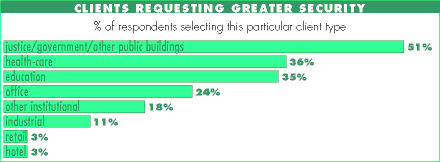
In a survey conducted by the AIA's economics and research department August 19–September 3, more than half (55%) of the 400 AIA architects responding say their clients have made building security a higher priority since the September 11 terrorist attacks. In addition, 46 percent say owners have ordered implementation of security features in a current building or a design over the last year.
Of those respondents who said security has become a higher priority for their clients, nearly half (48%) said they believe buildings are better protected against terrorist attacks than they were a year ago. According to the survey, owners are requesting security design features such as enhanced lighting; protected fresh-air intake systems; enhanced structural systems; and electronic access systems for parking lots, entryways, and elevators.
The survey also revealed that more than half of architects surveyed (51%) said owners representing justice facilities and government buildings are requesting security features. In addition, architects say that clients of health-care facilities (36%) and educational facilities (35%) also are requesting greater security. (These results reflect the client make-up of the architects who responded to the survey.)

Security consultants
agree
Peter DiMaggio of Weidlinger Associates, a New York City structural and
civil engineering consulting firm, said he is encouraged by the progress
made in improving building security. "There has been an interest
in making buildings safer, but one year is not enough time to implement
many of the [features] being discussed," DiMaggio said. "I think
over the next several years, buildings—especially new buildings—will
be better-protected against terrorists."
Security upgrades in place at the Pentagon are widely credited with saving lives when the terrorist-controlled plane struck the building on 9/11. These upgrades were developed in the aftermath of the Oklahoma City bombing, and included blast-resistant windows and wall reinforcement, said Heath Suddleson, Assoc. AIA, of DMJM Aviation, who served on the Pentagon Renovation Project from 1995 to 1997. "With each event, we incorporate lessons learned," said Suddleson. "The events of September 11 will again spur advances to building protection and awareness of current methods. Out of every horrible event come improvements."
Copyright 2002 The American Institute of Architects. All rights reserved.
![]()
|
Respondents said: "There is no need to convince clients of need. The difficulty is to identify "reasonable" levels of risk and response. We start by identifying security incidents that have already occurred within the company in question (often quite revealing). Then we move on to assessing the types of things that "could" happen. This is never easy or pleasant, but it is necessary." "Security is now always a topic of discussion in the initial development of projects not just an add-on in the later stages." "We are much more conscience of exiting and egress routes." "We ask our clients if they would like to program more security into their projects, but most do not go for it. Our projects are smaller . . . they know their staff personally and feel they are still in control because of this. We still suggest it, but most feel that no additional security should be required on these small scope projects." |
|